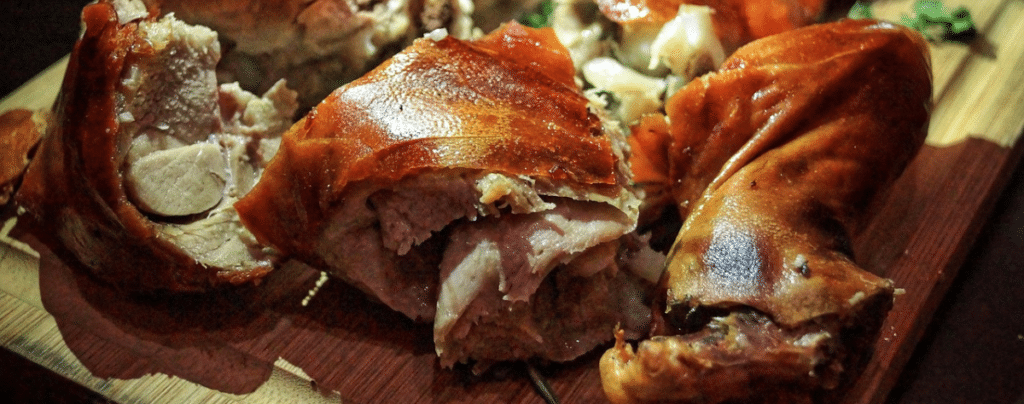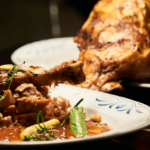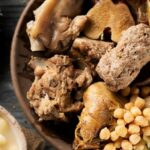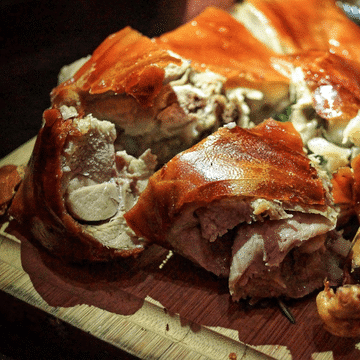
Traditional Spanish meat recipes you need to try
THE BEST MEAT RECIPES FROM SPAIN
Probably when you think about Spanish food the first thing that comes to your mind is fish and seafood. Of course, since we have a Mediterranean and an Atlantic coast! But meat is also huge in the cuisine of Spain, since the cattle industry has always been very important in our history, mountains and woods have offered hunting opportunities, and meat dishes helped warming up people in the cold nights of the countryside. And I’m not going to talk here about Spanish ham or other charcuteries and cold meats, I’ve already done that in previous posts. Today I’m going to share with you the elaborated traditional meat dishes that make part of every Spaniard’s food memories.
Traditional spanish meat dishes
1
Spanish Meatballs
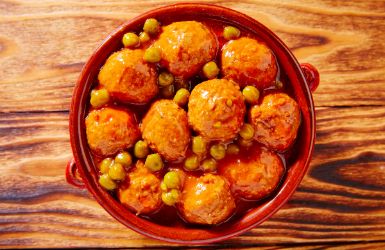
Spanish meatballs are a classic in anyone's childhood memories. And before you ask: no, we don't put them on sandwiches - that sounds very weird to any Spaniard! While meatballs are made in many parts of the world, In Spain it is believe that it was a poet and musician of the Cordova palace who in the 600's brought the recipe from the Middle East. Actually, the Spanish word "Albondiga" comes from Arabic and means "hazelnut" or "small ball".
In Spain meatballs are made of ground meat – usually pork, veal, chicken or a mix. The meat is mixed for consistency with egg and bread crumbles (sometimes imbibed with milk), as well as salt, pepper and minced parsley, and then the balls are formed and fried in olive oil. They are then served with a tomato, vegetable and wine sauce, and sometimes topped with green peas or small chunks of vegetables such as carrots. In Catalonia there’s a recipe that serves them with squid.
RECIPE IDEA: This is a pretty accurate version of Spanish meatballs.
WHERE TO EAT IT: In most traditional Spanish restaurants, sometimes also as a tapa in tapas bars, as well as in shops and market stalls selling homemade foods.
2
Fricandó, the Catalan beef stew
The Catalan cooking receives many influences of French cuisine, since Catalonia and France are connected through the Pyrenees. Fricando (from French “fricandeau”) is a good example of this. This dish is a flavorful veal stew, where the meat is finely sliced, coated in flour, then goldened on a pan with olive oil and set aside. With that same oil you then sautée some onion and optionally some grated tomato and other veggies such as carrots or leek. When the vegetables are cooked, the meat is brought back to the pan and wine and broth are added, together with wild mushrooms and “picada” (a Catalan preparation consisting in grounded garlic, almonds, old bread, parsley and some dark chocolate
RECIPE IDEA: This recipe is a more elaborated version of the basic fricando, but it’s easy enough. I’m not thrilled it says to cut the veal in chunks, though – do the thin slices instead.
WHERE TO EAT IT: In Barcelona and the rest of Catalonia you’ll find it the menu of many traditional Catalan restaurants. I’ve also often seen it in the stalls of the Boqueria market selling home made food and beans (not the touristy to-go stalls selling tacos).
3
Meat paella
And while some Valencia purists might derogatorily say that that’s “not paella but rice with things”, in the rest of Spain it’s totally acceptable… as long as it DOESN’T have chorizo on it (I’m looking at you, Jamie Oliver!). BTW, a “paella mixta” is a paella that includes both seafood and meat.
RECIPE IDEA: If you are up for the traditional Valencian paella, here is your go-to recipe. If you prefer a regular meat paella, this recipe gets you covered (you can swap the tenderloin by pork chops or sausage).
WHERE TO EAT IT. Paella and rice restaurants around Spain. These are my favorite paella restaurants in Barcelona, if it helps.
4
Redondo de Ternera
Redondo de ternera (Veal Round) is a particular part of a veal, with no sinews and very little fat. Despiste tending to be dry, when it’s cooked the right way it becomes tender and very pleasant to the palate. In Spain it’s often used as main dish in special days and it’s often served stuffed with veggies and nuts. Before roasting it, it’s often marinated in Mediterranean herbs, garlic and wine. It’s often served with a variety of vegetables, mushrooms and potatoes on the side or with a thick sauce made of the veggies that are roasted together with the meat.
RECIPE IDEA: It’s hard to find recipes in English, but I found this recipe for you that is quite representative of the traditional dish, except that instead of roasting it in the oven, it’s cooked on a casserole.
WHERE TO EAT IT: In Spain you are likely to find Redondo de Ternera in most traditional Spanish restaurants as well as in market stalls selling homemade foods.
Grilled and baked Spanish meats
5
Lechazo
RECIPE IDEA: This page gives you the traditional recipe plus a variation of the dish with honey on it.
WHERE TO EAT IT. Special Spanish meat restaurants called “Asadores” (roast houses). In Barcelona I recommend the Asador de Aranda (and for other meat restaurants go here)
6
Cochinillo
Also known in some areas as Tostón Asado, this traditional Spanish dish has been made in the center of Spain since the Roman times, just like lechazo. But instead of a suckling lamb, cochinillo is a suckling pig (from “cochino”, meaning pork in Spanish).
The recipe is similar to lechazo, but while lechazo is usually chopped in separate pieces, in the case of cochinillo it’s not unusual to see the full animal cooked (having previously removed the inside organs – although some times the kidneys are left for flavour). The pig is then coated in lard and optional herbs, put on a clay casserole and into the oven. Sometimes white wine or water is added for tenderness
RECIPE IDEA: Here you’ll find an easy recipe.
WHERE TO EAT IT. Asadores around Spain, but specially in Madrid and Castilla y Leon: the most famous place for cochinillo in Spain is Meson de Candido in Segovia.
7
Botifarra amb mongetes
RECIPE IDEA: This recipe is as plain as it sounds, but if feel you’ll need guidance, you’ll find it here.
WHERE TO EAT IT. Traditional Catalan restaurants in Barcelona and the rest of Catalonia. It’s not unusual to see it also in market tapas bars.
8
Chuletón
Chuletón is the part of the ox rib known as t-bone steak. It’s tender with marbled fat and found along the rib bone. It is served grilled or baked, rare or medium-rare, and it is typical from Castilla – specially from the Avila province, although in Galicia and the Basque Country they are also famous for their chuleton meats. Look for “buey” (ox) or “vaca vieja” (free ranged old cows) for the best meat quality.
RECIPE IDEA: This video of a chuleton being grilled is so calm and beautiful that it almost feels like a cooking meditation.
WHERE TO EAT IT. Asadores and steak houses all over Spain.
Spanish meat tapas
9
Croquettes
RECIPE IDEA: These chicken and ham croquettes look yummy. And this is a recipe made with stew leftovers.
WHERE TO EAT IT. Tapas bars all over Spain.
10
Morcilla
Morcilla is a cooked blood sausage made with ground pork meat, pork blood, rice and onion, as well as other optional ingredients and spices depending on the region of Spain where it’s made. It is often served grilled or fried in a little of olive oil, full or sliced, as a tapa or as the filling of a sandwich.
RECIPE IDEA: Really, unless you live in a farmhouse where you raise pigs and are going to slaughter them, you don’t need a recipe of how to make morcilla: Spanish people buy it just like you buy a normal sausage, then just grill it or fry it at home. It’s that easy.
WHERE TO EAT IT. Countryside restaurants and tapas bars all over Spain.
11
Pollo al ajillo
RECIPE IDEA: This is an easy recipe you can try at home.
WHERE TO EAT IT. Tapas bars all over Spain.
12
Choricitos a la sidra
Most of the time, people think of chorizo as a cold cut. But there’s a variety of chorizo that is meant to be used for cooking. It’s usually not as thick as the one used for sandwiches, with a size similar to a sausage, or also smaller ones that look like baby red sausages. One of the most traditional ways to make it is cooked in cider. This recipe is original from Asturias (where the best Spanish cider is made), but it’s also very popular in other areas of Spain such as Madrid. The sausages are optionally roasted before being cut in slices and putting them on a clay casserole where they are cooked in cider. They are served on the same casserole, after adding a light broth to the cider and the chorizo fat.
RECIPE IDEA: Try this traditional recipe that adds an extra touch of flavor with the aid of some herbs.
WHERE TO EAT IT. Tapas bars all over Spain.
Spanish meat dishes with game
13
Quail and partridge (codorniz & perdiz)
Quails are often made in “escabeche” vinegar-based marinade or fried with garlic and parsley (“al ajillo”), like the chicken we mentioned before.
RECIPE IDEA: This is how to make Toledana style partridge. And here is a step-by-step video of Escabeche quails.
WHERE TO EAT IT. Fine dining restaurants serving traditional Spanish cuisine.
14
Rabbit (conejo)
I know, this is a delicate subject because in many countries rabbits are seen and loved as pets, and it can be brutal to imagine them as food. But that’s the way it is. Actually, the Romans called Spain “Hispania”, that meant land of rabbits. And of course in those times people would it what was available… therefore eating rabbit in Spain has been common for many centuries even if nowadays you don’t see it so much in the big cities and it’s become something mostly seen in the countryside. You’ll see it baked, grilled, “al ajillo”, or as part of Valencian paella.
RECIPE IDEA: Rabbit “al ajillo” is an easy recipe to start with. And here is a more elaborated rabbit stew dish.
WHERE TO EAT IT. Traditional Spanish restaurants, mostly in the countryside, and in some Asadores, too.
15
Deer (ciervo or venado)
In Catalonia you’ll also see it stewed with some chocolate (Civet), or served with berry sauce.
RECIPE IDEA: This is the civet recipe I found in English. I couldn’t find a recipe of Ciervo en Salsa in English, so here I leave you one in Spanish in case you speak it or are happy to use a translation app.
WHERE TO EAT IT. Fine dining restaurants serving traditional Spanish cuisine, as well as mountain restaurants.
16
Boar (jabali)
Boar meat is different from pork because of its lower levels of fat, more aromatic flavor and juicier. In any case, any recipe used for pork can equally be used for boar, although boar also admits longer cooking times as its meat is a bit harder, so stews and civets are common Spanish recipes for boar.
RECIPE IDEA: This is a classic Spanish boar stew.
WHERE TO EAT IT. Mostly in mountain and countryside restaurants.
Offal Spanish recipes
17
Rabo de Toro (Oxtail)
RECIPE IDEA: Here is the traditional way to make it.
WHERE TO EAT IT. Traditional Spanish restaurants, some tapas bars and market bars.
18
Manitas de cerdo (Pig trotters)
Pig trotters are called “manitas” (hands) in Spanish but “peus” (feet) in Catalan. But the way to make them doesn’t differ much from one area of Spain to the other, and it’s similar to the way oxtail is made, but with added bacon and pimentón (the Spanish paprika) or alternatively chorizo.
RECIPE IDEA: Ok, it was impossible to find a recipe in English that wasn’t Asian or that was making a “sofrito” with the onion rather than adding the veggies to the broth. So I challenge you to use Google Translate to make this Catalan recipe.
WHERE TO EAT IT. Traditional Spanish restaurants, some tapas bars and market bars.
19
Callos (tripe)
RECIPE IDEA: This is a quite complete recipe by a famous chef.
WHERE TO EAT IT. Tapas bars all over Spain, and most Spanish restaurants in Madrid and Castilla
20
Cap i pota (Catalan offal stew)
Cap i pota (head and trotters) is a traditional Catalan offal recipe from the time when no animal parts could go to waste – in this case, veal parts. The part of the head that is used is the snout, and besides the veal trotters some recipes also add other animal parts such as tripe, ham, bacon or chorizo for extra flavor. Adding chickpeas is optional. BTW, for more offal and weird Spanish foods, check out this other post.
RECIPE IDEA: This is a quite accurate recipe, but where it says “chorizo pepper” it means pimenton (paprika). I guess the word “shank” means trotters and by lips they mean the snout.
WHERE TO EAT IT. Catalan food restaurants, specially those serving “esmorzar de forquilla“, as well as market tapas bars.
RESEARCHING FOR A TRIP IS TIME-CONSUMING…
Need more inspiration?
Our 100% FREE Barcelona Collection will give you everything you need to organize the trip of your lifetime to Barcelona.
BEST INSIDER TIPS FROM THE PROS!
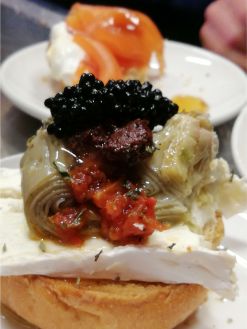
Last update on 2024-04-25 / Affiliate links / Images from Amazon Product Advertising API

